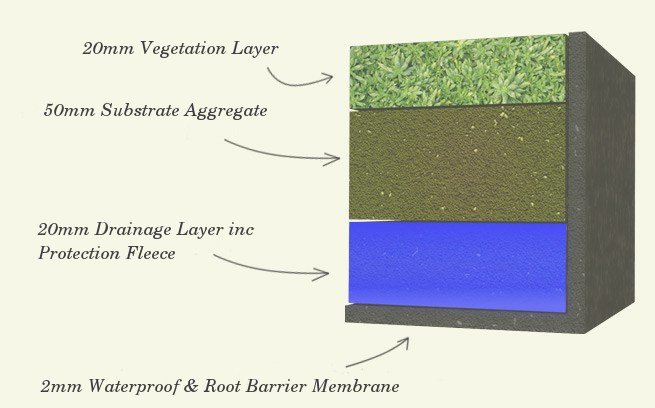WHAT IS A
GREEN
ROOF?
The term Green Roof has come to describe a roof which is green, not just in a literal sense but also in an economic and environmental sense. In other words it is energy efficient or sustainable. These systems have many different names such as a living roof, biodiverse roof, sedum roof, brown roof, eco-roof, grass roof, turfed roof, etc.
In basic terms, a green roof is a roof space that is either partly or fully covered in vegetation. Beneath this vegetated finish is the growing medium, drainage layer and then the all-important waterproof membrane. A necessary prerequisite prior to installing a green roof is to test whether the building can take the weight of our system.
Green roofs are highly versatile as they are compatible with most roof pitches, new builds as well as retrofit projects!
Components of Green Roofs
Green roofs come in three forms; intensive, semi-intensive and extensive, each of which have differing substrate depths. At Sedum Green Roof we specialise in supplying the lightweight extensive system which requires a shallow substrate depth most suitable for drought tolerant plants such as sedums.
Beneath the growing medium is a filter fleece layer which prevents the organic content from washing away while also allowing rainwater to percolate through to the drainage layer. The drainage layer stores and slowly releases water thus helping to manage excessive rainwater runoff.
At Sedum Green Roof we use a simplified modular system which includes all of these functional layers within it.
WHAT ARE
THE BENEFITS?
-

Roof Longevity
“Green roofs can more than double the average lifespan of conventional roof - from an average of 17 years to a striking 40 years” - BKV Energy
The UK's climate, with its heavy rain, strong winds, and seasonal hazards like freeze-thaw cycles and excessive UV radiation, puts a strain on roofs. Green roofs provide a protective barrier, shielding the structure from harsh conditions and extending its lifespan, saving building owners time and money on repairs.
-

Thermal Insulation
“Green roofs can reduce daily energy consumption for air conditioning by up to 70% during the summer months” - Greenmatch
In the UK, building heating and cooling can account for up to 25% of energy demand. Green roofs, with their insulative components, help maintain thermal comfort, reducing energy use, lowering operating costs, and cutting the building's carbon footprint.
-

Biodiversity Gain
Sedum is a huge magnet for all flora and fauna both large and small, Bees love it!
Green roofs provide vital nectar for pollinators during the Spring and Summer, enriching urban ecosystems. They also offer shelter for insects and birds, and when designed well, can support essential ecosystem services for humans.
-

Urban Heat Island Mitigation
“Green infrastructure such as green roofs have been found to reduce the temperatures of their immediate surroundings by as much as 1.2 °C”
Urban heat islands, caused by heat-retaining materials like concrete, can raise temperatures to harmful levels, especially with climate change. Green roofs, through evapotranspiration, help manage heat and reduce heat stress.
-

Stormwater Management
“Green roofs can retain up to 40-90% of rainfall thereby reducing flood risk within cities” - GRO
Climate projections for the UK predict more extreme rainfall, increasing flood risk, especially in urban areas with non-porous surfaces. Green roofs, with their porous structure, help absorb moisture and slow water flow, easing pressure on outdated drainage systems by reducing flood risk.
-

Future Planning
We are committed to improving and being greener year on year.
At Sedum Green Roof we are always looking at new ways to push the industry forward in terms of best practice. We are currently looking at low impact alternative materials, fertilisers and business models. Watch this space!
KNOWLEDGE HUB
●
KNOWLEDGE HUB ●
-

OUR SYSTEMS & PLANT VARIETIES
-

HOW TO INSTALL A GREEN ROOF
-

HOW TO MAINTAIN YOUR GREEN ROOF
-

FAQs
-

TIPS & TRICKS
-

NEWS FROM THE FARM

